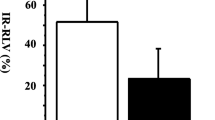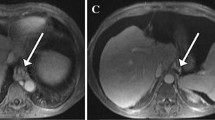Abstract
Objective
To investigate the relationship between the abnormal characteristics of sublingual collateral (SC) and portal vein hemodynamic changes in patients with primary hepatic carcinoma (PHC).
Methods
A total of 123 patients of PHC with abnormal SC were enrolled. The SC characteristics were classified and evaluated. The principal components (PC) of SC extracted from them by principal component analysis and the relationship between PC and the dynamic changes of portal vein fl ow were analyzed by correlation analysis.
Results
Three groups of PC were extracted, namely PC-1 (length, width, presentation type of visualization), PC-2 (circuitous, vesicular change), and PC-3 (color, collateral hemostasis, petechiae, ecchymosis). Their total accumulative contribution degree reached 56.803%. Correlation analysis shows that PC-1 was significantly positively correlated with the hemodynamic parameters of the portal vein (P<0.01), while PC-2 and PC-3 were not (P>0.05).
Conclusion
Length, width and presentation type of SC could be used for predicting the changes of portal venous pressure in PHC patients.
Similar content being viewed by others
References
Liu Q, Yue XQ, Ren RZ, et al. Characteristics of sublingual venae in primary liver cancer patients in different clinical stages. J Chin Integr Med (Chin) 2004;2(3):175–177.
Wu DB, Jin SY, Si ZX. Experimental study of hemodynamic changes of lingual vessels of rats with cirrhotic portal hypertension and its mechanism. Chin J Pathophysiol (Chin) 1996;12(4):422–424.
Li NM, Lin XD, Wang SY, et al. Clinical and experimental study on portal hypertension diagnosis by observing sublingual venae. Chin J Surg Integr Tradit West Med (Chin) 1994; 1(1):2–5.
Specialty Committee of Hepatocarcinoma, Chinese Antitumor Association. Clinical diagnosis and staging criterion of primary hepatocarcinoma. Chin J Hepatol (Chin) 2001;9(6):324.
Shangkuan H, Xinghai K, Shizhen Z, et al. Morphologic studies of the venous drainage of the tongue. Surg Radiol Anat 1998;20:89–92.
Zweibel WJ, Mountford RA, Halliwell MJ, et al. Splanchnic blood flow in patients with cirrhosis and portal hypertension: investigation with duplex Doppler US. Radiology 1995;194:807–812.
Zhang L, Chen RS. Traditional Chinese Medicine diagnosis Cooperation Group. 4417 cases of tongue cancer patients as clinical observation Zhejiang J Tradit Chin Med (Chin) 1992; 27(8):368–369
Zhang WT, ed. SPSS11 statistical analysis course. Beijing: Beijing Hope Electric Publishing House, 2002:190–210.
Ganem D, Prince AM. Hepatitis B virus infection—natural history and clinical consequences. N Engl J Med 2004;350:1118–1129.
Bosch J, Pizcueta E, Feu F, et al. Pathophysiolohy of portal hypertension. Gastroenterol Clin North Am 1992;21:1–14.
Okuda K, Obata H, Nakajima Y, et al. Prognosis of primary hepatocellular carcinoma. Hepatology 1984;4(Suppl):3S–6S.
Jin SY, Xue HX. Clinical significance of lingual and pulse diagnosis in chronic severe hepatopathy. J Pract Med (Chin) 1997;13(9):622.
Aoki H, Hasumi A, Hashizume M, et al. Hemodynamic analysis of findings in patients with portal hypertension: multicenter analysis in Japan. Japan Portal Hypertension Study Group. Hepatogastroenterology 1995;42:1030–1038.
Moriyasu F, Ban N, Nishida O, et al. Clinical application of an ultrasonic Duplex system in the quantitative measurement of portal blood flow. J Clin Ultrasound 1986;14:579–588.
Moller S, Bendtsen F, Henriksen JH. Splanchnic and systemic hemodynamic derangenment in decompensated cirrhosis. Can J Gastroenterol 2001;15:94–106.
Nagasue N, Dhar DK, Yamanoi A, et al. Production and release of endothelin-1 from the gut and spleen in portal hypertension due to cirrhosis. Hepatology 2000; 31:1107–1114.
Wu MC. Traditional Chinese medicine in prevention and treatment of liver cancer: function, status and existed problems. J Chin Integr Med (Chin) 2003;1(3):163–164.
Ling CQ. Problems in cancer treatment and major research of integrative medicine. J Chin Integr Med (Chin) 2003;1(3):168–170.
Author information
Authors and Affiliations
Corresponding author
Additional information
Supported by the National Natural Science Foundation of China (No. 30572434, 30500669, 30772698)
Rights and permissions
About this article
Cite this article
Deng, Wz., Lang, Qb. & Ling, Cq. Relationship between abnormal characteristics of sublingual collateral and portal vein hemodynamic changes in patients with primary hepatic carcinoma. Chin. J. Integr. Med. 14, 28–32 (2008). https://doi.org/10.1007/s11655-008-0028-1
Received:
Published:
Issue Date:
DOI: https://doi.org/10.1007/s11655-008-0028-1




